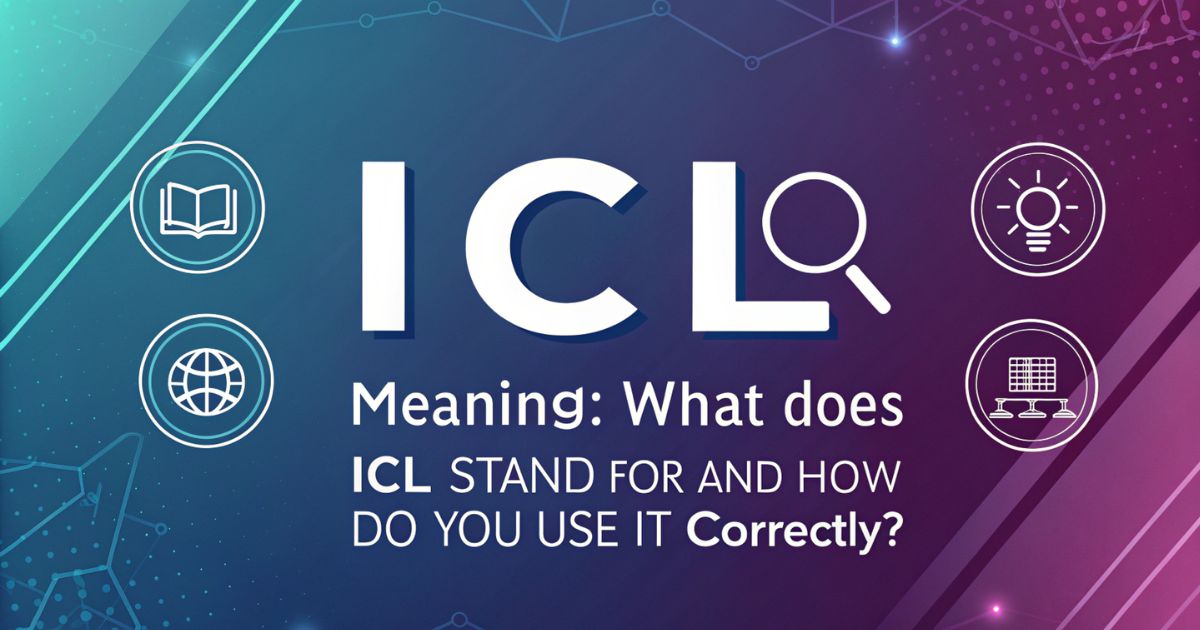You’ve probably stumbled across ICL while scrolling through texts or researching eye surgery options, and now you’re wondering what it actually means.
This three-letter acronym carries completely different definitions depending on whether you’re chatting with friends, consulting an ophthalmologist, or diving into business documents.
Let’s unpack every significant ICL meaning so you’ll never second-guess its context again.
What Does ICL Mean in Text Messages and Social Media Conversations?
When your friend drops ICL in a text thread, they’re saying “I Can’t Lie.”
This slang phrase functions as a conversational amplifier—think of it as digital emphasis before sharing something honest, surprising, or slightly controversial.
Instead of typing “honestly” or “to be real with you,” younger generations condense their authenticity into three swift letters.
You’ll spot ICL peppered throughout Twitter threads, TikTok comments, and Instagram DMs where brevity reigns supreme.
The phrase typically precedes a genuine opinion: “ICL, that movie was trash” or “ICL, you handled that situation perfectly.”
It’s become the Gen Z equivalent of prefacing statements with “not gonna lie” or “if I’m being honest.”
Unlike formal acronyms, ICL in texting carries zero professional weight—save it exclusively for casual digital banter with peers who understand contemporary internet linguistics.
Why ICL (I Can’t Lie) Became Popular Among Gen Z and Millennial Texters
The explosion of ICL usage traces back to social media’s obsession with radical transparency.
Platforms like Twitter and TikTok reward unfiltered takes, and ICL became shorthand for “here comes my raw opinion.”
According to Pew Research Center, 95% of teens use smartphones, creating fertile ground for acronym evolution.
Millennials adopted it slightly later, borrowing from Gen Z’s linguistic innovations around 2019-2020.
The acronym satisfies our cultural craving for authenticity while maintaining the speed-typing efficiency that mobile communication demands.
ICL also sidesteps the perceived insincerity of older phrases like “TBH” (to be honest), which some view as overused or disingenuous.
Linguistic researchers note that each generation crafts distinct digital dialects to establish in-group identity.
Using ICL signals you’re plugged into current slang evolution rather than clinging to outdated internet-speak.
How to Use ICL in Everyday Digital Communication Without Sounding Outdated
Deploy ICL when you’re about to share something unexpectedly honest or mildly controversial.
Example: “ICL, I’ve been avoiding your calls because I needed space.”
The acronym works best in informal environments—group chats, casual DMs, or comment sections where playful banter thrives.
Never transplant ICL into professional emails, LinkedIn messages, or formal correspondence where it’ll read as inappropriately casual.
Pair it with statements that genuinely warrant emphasis rather than sprinkling it randomly throughout conversations.
Overusing ICL dilutes its impact; treat it like hot sauce rather than table salt.
Watch how your conversation partner communicates before mirroring their slang usage—forcing acronyms into exchanges with people who prefer standard English creates awkwardness.
If you’re over 35, test the waters cautiously; what feels natural to a 22-year-old might land as “fellow kids” energy when you deploy it.
Context dictates appropriateness—ICL fits perfectly when discussing weekend plans but bombs spectacularly in parent-teacher conferences.
What Does ICL Stand For in Medical Terminology and Eye Surgery Procedures?
In ophthalmology, ICL represents Implantable Collamer Lens—a revolutionary vision correction procedure.
This surgical option involves placing a biocompatible lens inside your eye, between the iris and natural lens, to correct refractive errors.
Unlike LASIK, which permanently reshapes your cornea, ICL surgery adds a corrective element without removing tissue.
The “Collamer” material—a collagen-based copolymer—allows oxygen and nutrients to flow naturally through your eye.
According to the American Academy of Ophthalmology, ICL procedures have gained traction since FDA approval in 2005.
Surgeons typically recommend ICL lenses for patients with moderate to severe myopia (nearsightedness) ranging from -3.0 to -20.0 diopters.
The procedure also corrects astigmatism up to 4.0 diopters when combined with toric ICL variants.
Approximately 1 million eyes worldwide have undergone ICL implantation as of 2024, demonstrating its growing acceptance.
Recovery time averages 1-2 days for basic activities, though complete healing spans 3-6 months.
Understanding ICL Surgery: How Implantable Collamer Lenses Correct Vision Problems
ICL surgery begins with numbing eye drops—no general anesthesia required for this outpatient procedure.
Your surgeon creates a microscopic incision (typically 3mm) in your cornea’s edge to access the eye’s interior.
Through this tiny opening, they inject a folded Collamer lens which unfolds naturally once positioned.
The lens settles into place behind your iris, tucked safely in front of your eye’s natural crystalline lens.
This positioning allows the ICL to intercept incoming light rays and refract them correctly onto your retina.
The entire procedure lasts roughly 20-30 minutes per eye, though most surgeons space treatments 1-2 weeks apart.
Patients report immediate vision improvement—often achieving 20/20 clarity within 24 hours.
The Collamer material contains ultraviolet protection, shielding your retina from harmful UV rays.
Because surgeons don’t remove corneal tissue, ICL remains reversible—your doctor can extract the lens if needed.
This reversibility distinguishes ICL from permanent laser procedures, offering a safety net for patients concerned about commitment.
ICL vs LASIK: Which Vision Correction Method Delivers Better Long-Term Results?
LASIK reshapes your cornea using laser ablation, permanently altering your eye’s focusing power.
ICL adds a corrective lens without removing tissue, preserving your cornea’s natural structure.
For severe nearsightedness (beyond -8.0 diopters), ICL typically outperforms LASIK because extreme corneal reshaping can compromise structural integrity.
According to FDA clinical trials, 99.4% of ICL patients achieved 20/40 vision or better—meeting driving requirements without glasses.
LASIK boasts similar success rates but struggles with higher prescriptions where insufficient corneal thickness creates limitations.
ICL surgery costs significantly more—expect $4,000-$6,000 per eye versus $2,000-$3,000 for LASIK.
However, ICL delivers superior night vision quality because it doesn’t induce higher-order aberrations common with aggressive corneal reshaping.
Dry eye syndrome plagues roughly 50% of LASIK patients temporarily, while ICL rarely triggers this complication.
LASIK offers faster stabilization (2-4 weeks) compared to ICL’s 3-6 month healing timeline.
Ultimately, your candidacy depends on prescription strength, corneal thickness, and age—consult a board-certified ophthalmologist for personalized recommendations.
What Does ICL Mean in Business, Logistics, and International Commerce?
In commercial contexts, ICL frequently denotes International Container Lease or Intermodal Container Leasing.
Shipping companies use ICL agreements to rent standardized containers for transporting goods across borders.
According to World Shipping Council, approximately 90% of global trade moves via containerized shipping.
ICL contracts allow businesses to access containers without massive capital expenditures on fleet ownership.
Lease terms range from short-term (one-way trips) to long-term arrangements spanning several years.
Major ICL providers include Triton International, Textainer, and CAI International—collectively managing millions of containers.
The ICL model revolutionized logistics by standardizing container dimensions (20-foot and 40-foot units predominate).
Businesses leverage ICL services to scale shipping capacity dynamically based on seasonal demand fluctuations.
Another business interpretation: Internal Control Letter—documents outlining organizational compliance procedures.
Auditors issue ICL reports after evaluating a company’s financial safeguards and risk management protocols.
How Imperial Chemical Limited (ICL) Shaped Global Manufacturing History
Imperial Chemical Limited once stood as Britain’s largest manufacturing enterprise from 1926 until its 2008 dissolution.
The conglomerate produced everything from pharmaceuticals and plastics to paints and agricultural chemicals.
ICL’s origins trace to a merger of four British chemical giants: Brunner Mond, Nobel Industries, United Alkali Company, and British Dyestuffs Corporation.
At its zenith during the 1970s, ICL employed over 200,000 workers across six continents.
The company pioneered polyethylene development, revolutionizing packaging industries worldwide.
ICL’s pharmaceutical division created propranolol—the first beta-blocker medication—earning a Nobel Prize for researcher James Black.
However, conglomerate inefficiencies and fierce global competition eroded ICL’s dominance throughout the 1990s.
Strategic divestitures dismantled the empire; AkzoNobel acquired the paints division while other segments scattered to various buyers.
Though Imperial Chemical Limited ceased existing as a unified entity, its innovations permanently altered chemical manufacturing.
Legacy brands like Dulux paint still carry the DNA of ICL’s research legacy.
ICL in Education: What the Indian Cricket League Taught Us About Sports Branding
The Indian Cricket League (ICL) launched in 2007 as cricket’s rebel alternative to traditional tournaments.
Funded by Zee Entertainment Enterprises, ICL offered lucrative contracts to players excluded from official cricket boards.
This renegade league featured a Twenty20 format, team franchises, and aggressive marketing—foreshadowing modern cricket’s entertainment shift.
ICL teams like the Chennai Superstars and Hyderabad Heroes attracted international talent with paychecks rivaling official tournaments.
However, the Board of Control for Cricket in India (BCCI) wielded its authority, banning ICL participants from sanctioned cricket.
The Indian Premier League (IPL) emerged months later as the BCCI’s response, effectively suffocating ICL’s momentum.
By 2009, the Indian Cricket League collapsed under financial strain and player defections to the IPL.
Despite its failure, ICL demonstrated cricket’s commercial viability as mass entertainment rather than genteel sport.
The league’s franchise model, player auctions, and celebrity team ownership became IPL blueprints.
ICL’s brief existence proved that challenging established sports hierarchies requires both capital and institutional cooperation.
Where You’ll Encounter ICL in Technology, Computing, and Software Development
In programming circles, ICL sometimes references Interface Control Language—specifications governing software component interactions.
Developers use ICL documentation to ensure different code modules communicate seamlessly.
Legacy computing remembers ICL (International Computers Limited)—a British computer manufacturer prominent from 1968-2002.
ICL competed against IBM during mainframe computing’s golden era, supplying systems to UK government agencies.
The company pioneered the 2900 Series mainframes, which dominated British enterprise computing throughout the 1970s-80s.
Fujitsu acquired ICL in phases, fully absorbing it by 2002 and rebranding operations as Fujitsu Services.
Modern tech contexts rarely invoke ICL as a standalone acronym, though niche industries maintain specialized meanings.
Database administrators might encounter ICL in Oracle documentation referring to specific command utilities.
Network engineers occasionally use ICL for Integrated Circuit Layout when discussing semiconductor design.
Generally, tech’s rapid evolution renders older acronyms obsolete—ICL’s computing relevance has largely evaporated outside historical discussions.
Understanding ICL in Legal Documents and International Commercial Law Contexts
Legal professionals frequently encounter ICL representing International Commercial Law—the framework governing cross-border business transactions.
ICL principles harmonize conflicting national regulations when companies operate across jurisdictions.
The United Nations Commission on International Trade Law (UNCITRAL) establishes many ICL conventions that countries voluntarily adopt.
International Commercial Law addresses contracts, arbitration, shipping, payment mechanisms, and intellectual property across borders.
According to the World Trade Organization, standardized ICL frameworks facilitate approximately $25 trillion in annual global trade.
Businesses rely on ICL arbitration to resolve disputes without navigating multiple court systems.
The International Chamber of Commerce (ICC) administers the most recognized ICL arbitration services worldwide.
ICL conventions like the Vienna Convention on Contracts for the International Sale of Goods (CISG) govern sales between parties from different nations.
Understanding International Commercial Law proves essential for companies engaging in import/export, licensing, or foreign direct investment.
Corporate attorneys specializing in ICL command premium rates due to the complexity of multi-jurisdictional compliance.
How to Determine Which ICL Meaning Applies Based on Conversational Context
Context clues reliably signal which ICL interpretation fits your situation.
If the conversation unfolds via text message or social media with casual language, ICL means “I Can’t Lie.”
Medical discussions involving vision correction, eye surgery, or ophthalmology clearly reference Implantable Collamer Lenses.
Business contexts mentioning shipping, logistics, or container leasing point toward Intermodal Container Leasing or International Container Lease.
Historical manufacturing discussions likely reference Imperial Chemical Limited—especially if British industrial history surfaces.
Legal documents or international business negotiations indicate International Commercial Law.
Technology conversations about vintage computing or mainframe systems might reference International Computers Limited.
Cricket discussions involving early Twenty20 leagues signal the Indian Cricket League.
When uncertainty persists, simply ask for clarification—acronyms breed confusion precisely because they pack multiple meanings into minimal characters.
Professional settings demand extra vigilance; misinterpreting ICL in a medical consultation versus a logistics meeting creates vastly different consequences.
Common Mistakes People Make When Using or Interpreting the Acronym ICL
Texters over 40 frequently misread ICL as technical jargon rather than recognizing its slang origin.
Patients researching ICL surgery sometimes confuse it with ICL (Intraocular Lens)—standard lenses used in cataract surgery.
While related, Implantable Collamer Lenses specifically correct refractive errors in younger patients without cataracts.
Business professionals occasionally conflate ICL (container leasing) with FCL (Full Container Load)—a shipping term describing container capacity rather than ownership.
Students researching cricket history mix up ICL (Indian Cricket League) with IPL (Indian Premier League)—the latter being the successful, BCCI-sanctioned tournament.
Using ICL slang in formal writing tanks your credibility faster than typos—reserve it exclusively for casual digital exchanges.
Another frequent error: assuming ICL carries universal recognition when most acronyms remain industry-specific.
Dropping “ICL surgery” into conversation without context leaves non-medical audiences confused.
Always provide brief clarification when introducing niche acronyms: “I’m considering ICL—those implantable lenses that correct nearsightedness.”
Presuming shared knowledge alienates readers and listeners who lack your specialized background.
What Other Acronyms Get Confused With ICL and How to Avoid Mix-Ups
IOL (Intraocular Lens) frequently gets tangled with ICL in ophthalmology discussions.
IOLs replace your eye’s natural lens during cataract surgery, while ICLs supplement your existing lens for refractive correction.
IRL (In Real Life) shares similar letter patterns with ICL, creating texting confusion.
Context usually clarifies: “Let’s meet IRL” versus “ICL, that concert was incredible.”
ICE (In Case of Emergency) occasionally morphs into ICL through autocorrect mishaps.
ILC (International Logistics Company) resembles ICL in business documents—scrutinize carefully before signing contracts.
ICU (Intensive Care Unit) shares the “IC” prefix, sometimes triggering medical context confusion.
ICML (International Conference on Machine Learning) occasionally abbreviates to ICL in informal tech discussions.
Prevent mix-ups by spelling out acronyms during first usage: “I’m researching ICL (Implantable Collamer Lens) surgery options.”
Digital communication benefits from brief parenthetical expansions that eliminate ambiguity without disrupting conversational flow.
Quick Reference Guide: All Major ICL Meanings Across Different Industries
Texting/Social Media:
- I Can’t Lie (slang for emphasizing honesty)
Medical/Ophthalmology:
- Implantable Collamer Lens (vision correction surgery)
Business/Logistics:
- International Container Lease (shipping container rental agreements)
- Intermodal Container Leasing (equipment for multi-mode transport)
Legal:
- International Commercial Law (cross-border business regulations)
Historical Business:
- Imperial Chemical Limited (defunct British chemical conglomerate)
Sports:
- Indian Cricket League (defunct rebel cricket tournament)
Technology/Computing:
- International Computers Limited (defunct British computer manufacturer)
- Interface Control Language (software specifications)
Manufacturing:
- Integrated Circuit Layout (semiconductor design)
Bookmark this guide for instant reference when ICL pops up unexpectedly.
Frequently Asked Questions About ICL Meaning and Usage
What does ICL mean when someone texts it to you?
When someone drops ICL in a text, they’re saying “I Can’t Lie”—a modern slang phrase emphasizing honesty before sharing their genuine opinion.
It functions similarly to “honestly” or “to be real with you” but condenses the sentiment into three letters.
You’ll encounter this primarily in casual conversations with younger demographics who embrace abbreviated digital communication.
Is ICL the same as saying “to be honest” or “honestly”?
ICL carries nearly identical meaning to TBH (to be honest) but feels fresher to Gen Z users who view TBH as slightly dated.
Both phrases signal forthcoming authenticity, though ICL emerged more recently around 2018-2019.
The functional difference remains minimal—think of them as generational synonyms within internet slang evolution.
Can ICL have negative connotations in text conversations?
ICL itself remains neutral, but what follows often determines whether it reads positively or negatively.
“ICL, you crushed that presentation” delivers praise while “ICL, your outfit missed the mark” offers criticism.
The acronym simply amplifies whatever sentiment accompanies it rather than carrying inherent positive or negative weight.
How much does ICL eye surgery typically cost in the United States?
ICL surgery ranges from $4,000 to $6,000 per eye across most U.S. markets.
Geographic location, surgeon experience, and facility prestige influence final pricing.
Major metropolitan areas like New York or Los Angeles typically charge premium rates compared to smaller cities.
Is ICL vision correction covered by health insurance plans?
Most health insurance classifies ICL surgery as elective cosmetic procedure rather than medical necessity.
Insurance rarely covers refractive surgery costs, though HSA (Health Savings Account) and FSA (Flexible Spending Account) funds typically qualify.
Some vision insurance plans offer modest discounts through preferred provider networks—check your specific policy details.
What’s the recovery time after getting ICL lenses implanted?
Initial ICL recovery allows most patients to resume normal activities within 24-48 hours.
Complete healing spans 3-6 months as your eye fully adapts to the implanted lens.
Avoid swimming, contact sports, and eye makeup for approximately two weeks post-surgery to prevent infection.
Who qualifies as a good candidate for ICL surgery?
Ideal ICL candidates have moderate to severe nearsightedness (-3.0 to -20.0 diopters) with insufficient corneal thickness for LASIK.
You should be 21-45 years old with stable vision prescriptions unchanged for at least one year.
Pregnant or nursing women should postpone ICL surgery until hormones stabilize.
Can you reverse ICL surgery if you’re unsatisfied with results?
Yes—ICL reversibility distinguishes it from permanent laser procedures.
Surgeons can remove or replace the Collamer lens if complications arise or your vision needs change.
This safety feature appeals to patients hesitant about irreversible corneal reshaping.
Conclusion
ICL’s chameleon nature demands contextual awareness whether you’re texting friends, consulting eye doctors, or reviewing shipping contracts. Misinterpreting this three-letter acronym can range from mildly embarrassing in casual chats to professionally costly in business negotiations. Master these definitions, and you’ll navigate every ICL encounter with confidence rather than confusion.
More Posts
Ligma Meaning: Understanding the Internet Meme and Its Cultural Impact
HY Meaning: What It Stands For, How It’s Used & Alternatives to “Hiatus”
JFC Meaning Updated (2025) – Usage, Alternatives, and Context

Welcome to Brightnis! I am the admin and creator of this platform. I love questioning ideas and exploring different situations. My goal is to encourage critical thinking and help people see things from new perspectives. Join me in discussing thought-provoking topics and finding unique solutions to everyday challenges!






